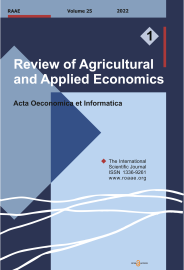KEYWORDS:
adoption; improved rice varieties; propensity score matching; logit; Northern Ghana
DOI NUMBER:
10.15414/raae.2022.25.01.42-54
ABSTRACT:
Research background: Adoption of improved rice varieties remain paramount in fighting food and nutrition insecurity across sub-Sahara Africa (SSA). A lot has been done in the space of the adoption of agricultural innovations and food and nutrition insecurity. However, studies on the drivers of improved rice variety adoption and its effect on rice output, considering time and location-specific factors, are limited.Purpose of the article: This study estimated and examined the drivers and effect of improved rice variety adoption on rice output in the northern region of Ghana.
Methods: A multistage sampling technique was employed to select 404 rice farm households in the northern region of Ghana. Propensity Score Matching (PSM) approach was used to analyse the data.
Findings, Value added & Novelty: This study provides literature on drivers of improved rice variety adoption and its effect on rice output, by jointly considering time and location-specific factors. The empirical results revealed that adoption of improved rice varieties has significant positive effect on rice output of farm households. This could translate into reducing food and nutrition insecurity and the importation of rice into Ghana. Similarly, improved rice varieties adoption is positively and significantly affected by family labour, membership in FBO, farmers’ perception of rainfall, awareness of government rice policy, telephone ownership, and closeness to input markets. However, the adoption of improved rice varieties bears a significant negative relationship with the age of a farmer and mechanization. To enhance rice productivity and food security outcomes, the study recommends that the development of enhanced rice varieties responsive to current climatic situation. Dissemination and promotion of the varieties should be given priority among stakeholders in the rice value chain. Farmers should be encouraged to join or form farmer-based organisations (FBOs) and support their farm work with family labour to minimize rice production costs due to external payments. Access to market by farmers should be enhanced by improving rural road networks, especially in the rural areas where rice production takes place. Government policy towards rice production should be well designed and communicated to rice farmers since awareness of government rice policy stimulates improved rice varieties adoption among rice farmers.
Please Cite this Article as:
Clement Y. LAMPTEY, Nashiru SULEMANA, Samuel A. DONKOH, Abraham ZAKARIA, Shaibu Baanni AZUMAH (2022) The Effect Of Adoption Of Improved Varieties On Rice Productivity In The Northern Region Of Ghana. Review of Agricultural and Applied Economics. XXV (Number 1, 2022): 42-54. doi: 10.15414/raae.2022.25.01.42-54
URL for sharing:
https://roaae.org/1336-9261/doi/abs/10.15414/raae.2022.25.01.42-54
FULL TEXT PDF:
▼ direct download link| view online in fullscreen ▲
References:
▼ direct download link

